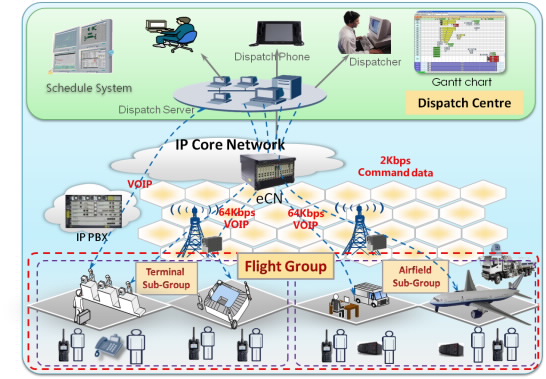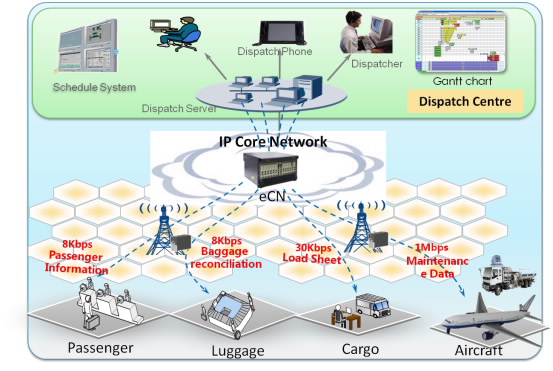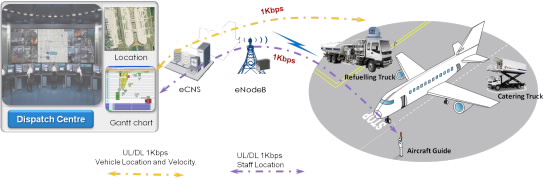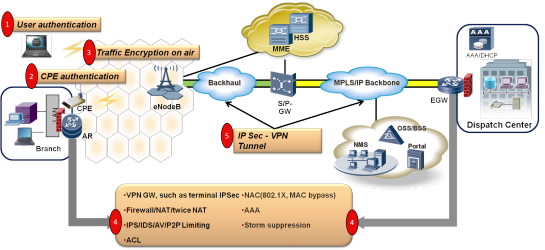Solución de Huawei para el procesamiento inalámbrico en tierra para aeropuertos
These years civil aviation plays more and more important roles in transportation, meanwhile it is also the most rapidest and potential transportation industry in next twenty years. With the rapid development, the passenger and cargo traffic increase beyond imagination. On the contrary, the airport becomes more and more crowded. How to guarantee ground service quality and air transportation safety, make sure flight punctuality rate, improve ground handling efficiency, reduce operating costs, all these are great challenges which airports are facing. Airport managers and operators have become increasingly dependent on IT&S to increase their airport’s capacity and security.
Airport Challenges
These years civil aviation plays more and more important roles in transportation, meanwhile it is also the most rapidest and potential transportation industry in next twenty years. With the rapid development, the passenger and cargo traffic increase beyond imagination. On the contrary, the airport becomes more and more crowded. How to guarantee ground service quality and air transportation safety, make sure flight punctuality rate, improve ground handling efficiency, reduce operating costs, all these are great challenges which airports are facing. Airport managers and operators have become increasingly dependent on IT&S to increase their airport’s capacity and security.
What’s the Problem
With the increasing flights in most of airports the ground resource is limited to handle increasing passenger and cargo traffic. More and more people are focusing on flight delay.
Inefficient dispatch leads to flight delay:
Most of airports use interphone for dispatch. Interphone is really useful and helpful in airport dispatching in past years. But all the important information is transferred in a moment, it can’t be recorded. We can’t make sure the right person at the right location get the right information. It is noisy on airfield, amount of information, for ground crews they need to remember all the voice command, but it is error-prone. In many cases their working practices are dominated by paper-based process and voice-based communications. Both can hamper efficiency, reduce productivity and lead to errors. Furthermore, all the process can’t be recorded for later analysis. The inefficient dispatching leads to flight delay directly.
No suitable network supports data service:
In air transportation industry flight punctuality rate is a key indicator to measure airline service quality. Flight delay will cost about 0.6-2.9% operating income of airline every year. For ground handling some key points impact flight delay heavily. By now all these key points service is paper-based and transferred manually. As we know the load sheet is built after airline close check in, in these 30 minutes load sheet and balance sheet need to be made accurately. Normally, there is just 7 to 8 minutes left to transfer manually these sheets to each flight. For the remote aircraft slot it will certainly lead the flight delay to take off. Another example is luggage search, the luggage should be taken down if the passenger does not board, but there is just 5 to 6 minutes left to transfer these passengers’ information, loader need to check each container and each barcode to find the luggage. This is inevitable to lead flight delay. Unfortunately, by now there is no reliable network which can support all these business data transfer.
Urgent Requirement Vehicle Management:
Kinds of support vehicles serve for each flight, however there are just little special vehicles in an airport, for example, refuel tank, ferry bus, snow blower and so on. Reasonable dispatching and surveillance is very necessary to improve handling efficiency and safety. Bus scheduling is also chaotic: coordinating drivers depends on radio communications to find out where and when they can take passengers off a flight. A late arrival and no available bus can mean further delays. The dispatcher may not be able to identify the best person for the job (based on location or availability)
Civil official statistics shows that about 40% non-aeronautic accidents in airport is the vehicle collision with aircraft. Vehicle localization and management is the urgent requirement for airport manager to improve airport safety.
Issues Facing Emergency Situation:
One of the most common reasons for flight delays is weather, which can affect a large scale scheduled flight directly or indirectly, While delays shot up, so did consumer complaints about service. Flight delays are frustrating, costly and a source of rage for the passengers that are caught in them. Additional pressure came from the increased volume of halted flights which are waiting for taking off. In this situation, how to deal with emergency, how to get the first hand information, for instance the video and picture to the dispatch centre and airline, it is really difficult for airline and airport, for by now there is no wireless network available in airport for wireless video and picture transmission.
Wireless Network LTE for Airport
Requirements for wireless covers nearly every aspect of an airline's airport operation: Curbside check-in, roving agents, clubs, maintenance, crew ready rooms, aircraft and cabin support services, kiosks, baggage reconciliation, cargo and so on. Wireless solutions help improve operational efficiency while delivering timely information, leading to better decisions and better outcomes.
Industry forecasts demonstrate strong market adoption rates for LTE leading to the necessary volumes for driving economies of scale. Within a decade, it is anticipated that the majority share of commercial wireless networks will utilize LTE technology platforms.
LTE (Long Term Evolution), also known as 4G is the perfect technology for building the next-generation of broadband networks, delivering applications such as video-based situational awareness that more difficult with TETRA. LTE offers high throughput (up to 100 Mbps) and low latency (10 ms), making it compatible with any mission-critical application.
Huawei’s Wireless Ground Handler Solution
Huawei as a global leader in end-to-end wireless coverage and capacity solutions, we bring forth airport wireless ground handling solution based on LTE timely. In addition to LTE infrastructure, Huawei’s leadership in handsets and CPE, leading backhaul solutions and experience in deploying LTE networks means that Huawei will bring a compelling LTE end-to-end system.
New Dispatch Mode: PTT, Voice and Command Data Together
Aim at improving efficiency and reducing error and miscommunication caused by paper-based processes and voice-based communications, solution of PTT and workflow is the best way. Figure-1 shows the PTT and Work flow application scenario.

Figure-1 PTT, Voice and Command Data Application Scenario
In the dispatch centre all task has been scheduled based on the flight plan, according to the flight dynamic information, dispatch system will remind dispatcher assign the task timely with PTT. Same time the work flow is sent out with PTT. Benefit from the workflow and Gantt chart all task status and ground crew’s status can be mastered by dispatcher.
Gateways to the public network, standard interfaces to enterprise telephony, PBX, with the option of a single dialing plan. It is seamless communication for mobile phone and IP phone. It integrates all the ground handlers including in terminal and on airfield.
Flight-oriented dialing enables immediate communications between all personnel involved in the turnaround of an aircraft at the gate (i.e., ramp agent, load master, cargo, catering or cleaning) can be contacted via simple code and the flight number. Group call features include pre-defined communication groups and groups which can be assigned dynamically, as processes or deployment of resources dictate.
Work Flow Order: Visual Dispatch for Airport
Workflow management systems help streamline business processes and increase productivity. General workflow specifications include the actions to be performed, routing information and policies that describe the organizational environment.

Figure-2 Work Flow Order Application Scenario
Figure-2 is the work flow order application scenario, the dispatch system sends the work order with PTT step by step automatically. There are five steps in the work order flow, every step status is displayed in the dispatch centre. All these five steps make the right person at right location get the right information. When something wrong in a step, dispatch system will alarm, the dispatcher can reassign the task to the ground crew with PTT. All these are visual to not only to dispatcher but also to ground crew.
The solution reduces error and miscommunication caused by paper-based processes and voice-based communications.
Automatic Mode: Information Release, Data Transfer
LTE wireless network dispatch solution removes delays and errors inherent in many of outdated processes. Figure-3 is the information release and data transfer application scenario.

Figure-3 Information Release, Data Transfer Application Scenario
The load sheet is transmitted by LTE wireless network with txt mode in place of manual transmission. After the airline finishes the load sheet and the dispatcher sends the load sheet to the flight directly. It will cost just several seconds. With the wireless printer installed on the luggage truck the load sheet is printed then signed by the pilot directly. About 10 minutes is left for loader to adjust the luggage and cargo, meanwhile it is safe and the flight will not be late for the latency of load sheet transmission. It is timely, accurate, costless, effectively. Decrease fault because of paper-based process.
For the ground service crews, the accurate flight information is significant, for all the service is based on the dynamic flight information. When the flight schedule is changed, the latest flight information is transmitted to all the crews automatically. The configuration ensures only messages of relevant interest to each department are received (e.g. message to catering when passenger load changes, to maintenance department when flights canceled or delayed, to crewing when new flights introduced). Flight/Duty/Credit hours updates based on actual flight dep/arr. Information.
These are our solution to resolve delay, the load sheet and flight task are transmitted by network. Real-time business data deliver can save 5-10% labour cost, the efficiency will be improved 5-6 times.
Vehicle Localization and Management
Consider numbers of motorized vehicles that are buzzing around the airport at all hours. It is urgent to track and manage airport supporting vehicles in order to decrease accidents by vehicles in airfield and enhance the supporting vehicles utility.

Figure-4 Vehicle Localization and Management
Vehicle track solution is based on GIS. In our solution the airfield is divided into different secure level area, different vehicles with different authority in the vehicle management platform. The location is transmitted in continuous intervals of anywhere between every 3 seconds to 5 minutes. When the vehicle goes to the restricted area, sound and light alarm will remind the driver and dispatcher at the same time.
Vehicle management, being able to manage the schedules with a closer watch, means that we can make changes in scheduling based on need. Sometimes the best plans do not always work, so being flexible by using a GPS tracking helps to know where and when to adjust schedules. The GIS based to identify the nearest available vehicles can relay task and routing information directly to driver’s mobile.
Vehicle tracking and management solution helps to schedule the vehicle reasonable and reduce fuel consumption costs and improving operations.
Wireless Video Surveillance and Picture Transmission
Inevitably, every corner of the airport will not be being watched at all times. It’s therefore important to consider where the blind spots of the airport are, and how these can be minimized. It’s also important that security personnel recognize blind spots, and that they are areas that see less activity from individuals. All these can be resolved by wireless video surveillance, it is the LTE that can bear the video.

Figure-5 Wireless Video Surveillance and Picture Transmission
An individual takes the handset to the spot(e.g. terminal, parking apron), real-time surveillance is sent to the dispatch centre, different video format are transferred to then sent to required departments, such as, medic, baggage, airport operations or airline over the internet. This allows authorized users to monitor airport activities from off-site locations. It is very useful to airline to monitor remote aircraft operation. With wireless video solution mobility monitor, operation monitor and aircraft operation monitor are possible for airport operation. These video is transferred to dispatch centre, in the dispatch centre all the video can be reformed to different format as requirement.
Wireless IP video surveillance systems are scalable, they can grow as needed, or as the airport grows. Additional cameras are easily connected to the network.
In a conclusion, taking advantage of Internet cameras helps not only in saving money and time with its ease of use, it can greatly increase the safety of airport users.
LTE_ Security Network for Airport
Secure operation is a solid foundation for security solutions safe in airport operation. Huawei’s solution provides versatile embedded hardware and software security solutions, it provides a reliable protection mechanism for sensitive data and transactions, and it can be shared simultaneously with secure and application.

Figure-6 Terminal to network security
Figure-6 shows terminal to network security solution. Compounding the challenge is the need to support high throughput requirements with mixed packet size traffic characteristics along with low latency requirements to preserve Quality of Service in voice and video applications. Increasingly, the design includes security at different layer.
- 1) User authentication;
- 2) Terminal hardware authentication;
- 3) Traffic Encryption on air;
- 4) VPN GW, such as terminal IPSec, Firewall/NAT/twice NAT, IPS/IDS/AV/P2P Limiting, ACL
- 5) IP Sec - VPN Tunnel
All these security method provided comprehensive security environment for airport operation. With these security solutions all the operation is reliable.
Why Huawei
There is badly need for new dispatching system to handle increasing flight and cargo traffic. New dispatching needs new wireless network which can support all these new service. Huawei as a global leader in end-to-end wireless coverage and capacity solutions, we bring forth airport wireless ground handling solution based on LTE timely. With our solution airport can improve ground handling efficiency and safety.
Huawei’s wireless ground handling solution with global local partner’s support, we can help you set up a reliable, safety and efficiency service.
For more information please contact the author: Marketing & Solutions Marketing Execution Dept, Yang Guangqin, email: guangqin.yang@huawei.com
